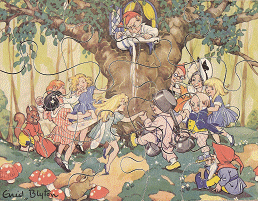What are Fairy Trees? January 16, 2018
Author: Beach Combing | in : Medieval, Modern , trackbackNothing about fairies is easy but Beach is getting more and more confused about one aspect of fairy life and that is their trees. In the Gaelic-speaking world (or what was the Gaelic-speaking world, RIP) thorns were commonly associated with fairies. These are the trees that workers are sometimes terrified about cutting down. In Wales (and apparently in some parts of England, provisional statement) oaks were associated with fairies. There was, for example, near Wrexham a ‘Fairy Oak’ which we have previously visited on this site. But what did the fairies do with their trees? There are perhaps three ‘obvious’ answers, none of which make much sense. (i) they lived in them; (ii) they danced at them; (iii) the trees had some kind of tribal importance for them.
Let’s peel off the least convincing ones. Forget twentieth-century spiritualist scree about fairies being tree men: in traditional British and Irish fairy-lore there is no sense that fairies were trees or that they lived in trees in an Enid-Blyton-the-Faraway Tree way. So fairies residency of the trees has to be given up. (Note that with fairy rocks there is more ambiguity.) The idea that fairies dance at trees is a little better documented but not much. Here is mad old Edmund Jones, speaking though something like sense at the end.
This young woman’s grandfather Wm. Jenkins, for some time kept a school at Trefethin Church, and coming home late in the evening, used to see the Fairies under an oak within two or three fields from the Church, between that and Newynidd Bridge. And one time he went to see the ground about the oak, and there was a reddish circle upon the grass, such as have been often seen under the female oak, called Brenhin-bren, — (King-Tree) wherein they danced… The Fairies dance in circles (which some writer, on the side of Infidelity unreasonably explain another way) in dry places; and the scripture saith that the walk of evil Spirits is in dry places ; Math. xii. 44 chiefly under the Oak-tree, the female Oak especially, likely because of its more spreading branches, and of a greater shade under it. Perhaps also, and very probably, because of the superstitious, Idolatrous use made of it beyond other trees in the dark times of Paganism, which is an apostasy from God and true religion, in which the Spirits of darkness delight.
Is it possible, finally, that ‘trees’ were a kind of totem of the tribe. Here there is an interesting parallel with local human communities. In early medieval Ireland the mini Irish kingdoms the tuath included a tribal tree. Perhaps the oak and the thorn had fundamentally different values? drbeachcombing AT gmail DOT com
An old friend of this blog, Bob S, 29 Jan 2018, writes in: I found your article interesting, but you didn’t mentioned Mountain Ash (Rowan), a tree sometimes considered as a fairy tree too. I found several references online to them being considered as “fairy trees”. I found the following passage which gives an example of the connection between fairies and rowan. It is from in an article on “Highland Antiquities and Statistics- Tay- Bridge” in the Perthshire Courier of 29th September 1842 p.3. “…A little farther east [of Ben Lawers] the eye has an extensive prospect of the fertile and beautiful vale of Appin, the country or territory of the Menzies’s. In this vast tract of land, a little beyond the ancient village of Dull, a number of knolls are seen planted with the favourite “rowan,” &c. These knolls are called by the Highlanders in their vernacular language, “Tomain nan shithichean.”— Anqlice, “the hillocks of the fairies.” These fairies were believed the superstitious mountaineers to hold midnight revels upon their smooth summits, under the soft and hallowed moonlight. Often the benighted Celtic traveller in passing any of these beautiful Tomains,” distinctly heard proceeding from them the most harmonious and exquisite sounds, and with astonishment perceived the subterraneous inhabitants gracefully adorned and clad in green, (their favourite and prevailing colour,) engaged in the dance. Many are consequently the tales of wonder and amazement which relieve the monotony of winter evenings, whilst the cottagers relate to their children the numerous anecdotes fairy land which their ancestors have handed down from generation to generation, and are even listened to with intense interest….. ” The folklore about Rowan seems to be ambivalent and confusing with regard to fairies. The tree is often connected with protection from enchantment and witchcraft, and some specify the trees, wood or berries protect from the fairies. On a more modern source I saw said the white flowers of the Rowan, (as found on hawthorn), that was the reason it too was considered as a fairy tree.



